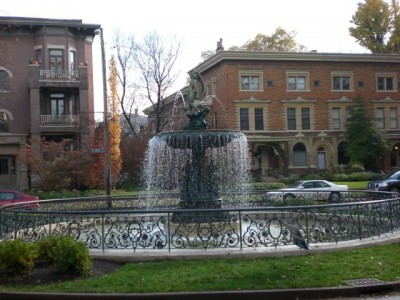BELGRAVIA
(click on pictures to enlarge)
Any time spent prowling these two great adjoining neighborhoods is a treat for the eyes and senses. Mature landscaping, impeccably restored turn-of-the-century homes and the well-designed boulevards of both neighborhoods yield an urban planner’s feast. All the virtues of urban landscaping simply seem so implicit in the design. It gives an incredibly satisfying sensuality to the ambiance of such a relaxing and all-enveloping stroll along these gorgeous streets and sidewalks. Sights and even smells abound. Lavenders, Mints of various types and those other gorgeous scents of exotics and even the odor of some of the native flora make it seem even more scrumptious somehow.
At this time of the season – late Fall – you get the benefits of the colors of deciduous leaves (as in the Burning Bush above) and the aroma of their deterioration, mixed with some fireplace smoke and the spicy effects of scented plantings. It’s funny. The smells are almost what I remember most when I walk this gorgeous area. You get those effects, mixed with what I often assume is the distillery smell of corn mash. Yummy stuff.
In the end, it is difficult to say what strikes one as the most impressive aspect of either of the two streets. There is simply so much to like. From its obviously planned beginnings, the urban master plan offers a very organized and supportive environment for the best sort of living. The area demands that you walk it, even if you live there. Time spent outdoors is an inherent positive. As mentioned, the odors, the plantings and the gorgeous revolving seasonal effects are pretty mind-blowing, really. It takes such splendid advantage of a true 4 Season climate.
Secondly – but still equally impressive – are the designs of the homes themselves. These are not your garden variety tract homes. Yes, it was a classic “tract” at its onset, but any similarity with our modern concept of tract housing stops at pretty much the first pace. Designers had a field day with these varied and special homes. Where St. James Court has these stately mansions in a riot of designs, Belgravia has a much more urban and “squeezed” look. These homes are close enough to practically be apartments together, with far less independent land between the homes.
The craftsmanship of these buildings is pretty doggone impressive. I especially love the masonry. Check out these bits of brick work, now over 100 years old but as impressive as any European work, using American products:
Even this one, still in the process of renovation, sand-blasting and then refurbishing (and note too the gorgeous old glass windows):
Kentucky is always noteworthy for the astounding variety and perfection of its many craftspeople. Wood, for example, in Kentucky, is a medium of incredibly wide usage using an amazingly wide assortment of tree products. Mandolins, sculpture, even those incredibly gorgeous “weed pots” illustrate the inherent beauty of the craftsman’s touch and are in huge demand, world-wide. It is said that Kentucky actually possesses the widest range of living and native species of trees in the world. All these trees, from the native Kentucky Coffee Tree to the various Cedars, Pines, Redbuds and Dogwoods, provide a stunning array of products for the wood craftsman.
But what stunned Frederick Olmstead, Edison and many more modern others was also the professionalism of the artisans so abundant in that interesting state. The stonework on these homes is somewhere beyond world-class, if such a thing can be said. The bridges alone in Cherokee Park are famous for their craftsmanship and beauty, much less the stone work on the fabulous and various mansions built around the the period – and later – when Louisville’s homes were constructed.
All this naturally mirrors an ethic very much alive in this town so immersed in American history and in native American Crafts. I’ll cheat now and show a bit of the downtown area as well, simply because I love baseball so much and always manage to find a spot for The Big Bat! OK, guess what this baseball bat represents!
Baseball fans won’t have much trouble recognizing the Louisville Slugger premises. Here is where every Louisville Slugger baseball bat is and has been hand made for Pro Ballplayers since 1890. The tour is really delightful and includes a museum where baseballs signed by every US President are displayed and including signed bat contracts from players like babe Ruth to Willie Mays and Barry Bonds. For collectors, it’s the equivalent of Fort Knox, lol.
In closing this post, I want to further emphasize Louisville’s intense interest and now-abiding care for its own fabulous history. The shots below are all taken along Main Street, a street teeming with old Iron Buildings now being renovated and upgraded to modern usages, but with the historical facades kept and refurbished, intact. It is not only a trip through a great history, but also a trip to witness architectural wonder and the craftsmanship that allowed such a pass in reality. Enjoy and thanks for dropping in.
Now THIS is a street light! 🙂

























